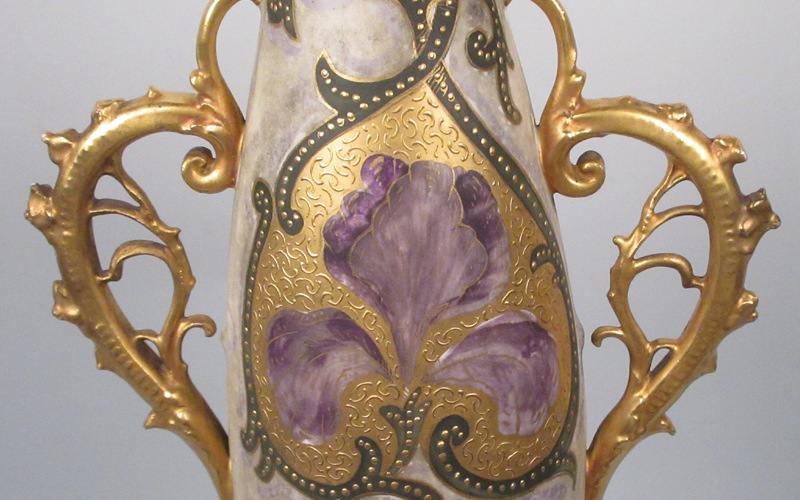October 1, 2019
This July at the annual Pottery Lovers week in Zanesville, Ohio, I purchased an ornate hand-painted vase, measuring 19.75″ t. and marked WM LYCETT / ATLANTA / GA with a lemon-shaped mark. It was decorated with iris blossoms inside heart-shaped reserves, and I noticed too its highly patterned pastel background, gilt stippling, and curvilinear Art Nouveau “ribbons.”
At the time, I knew nothing about this gorgeous artwork other than what I could see in person. It turns out to be a historically fascinating example of America china painting.
My first research step was, of course, to ask Google. That step identified a knowledgeable curator, Dale L. Couch, who told me about a detailed historical essay on Lycett China, which was published in 2012 by the Georgia Museum of Art, as part of their 6th Henry D. Green Symposium of the Decorative Arts. Michelle Miller wrote about the Lycett Studios to offer context for an exhibition of these works at the Museum between December 2011 and March 2012. The Museum is part of the University of Georgia.
I learned that the company Lycett Studio was the brainchild of William Lycett (1855-1909), son of the master china painter and teacher Edward Lycett (1833-1910), who is today best known as art director of the Faience Manufacturing Company (NY) between 1884 and 1890. (Here’s what the Metropolitan Museum of Art says about the father: https://www.metmuseum.org/toah/hd/lyce/hd_lyce.htm.) So the mark on my vase indicated that it was decorated in Atlanta, at the son’s studio there.
In 1883, after learning china painting under his father’s tutelage, his son William Lycett (1833-1910) moved to Atlanta to open his own studio–and following his father’s footsteps, William quickly became a highly regarded teacher of china painting himself. However, in contrast to the often monumental Faience Manufacturing works, which were typically made by the company and under the elder Lycett’s direct supervision, the Atlanta concern usually painted fine china blanks imported from overseas, from France, Austria, or another European maker. These could be gilt and monogrammed dinnerware or luncheon services. Or they could be individual serving pieces, as well as more decorative vase forms.
It was about 1890 that Edward joined his son by moving to Atlanta. According to a 1941 memoir by William’s grand-daughter Lydia–Edward himself painted a number of works at the William Lycett Studio!
Indeed, in 1941 about 350 examples of Lycett china were exhibited at the Atlanta Historical Society–with attributions to various family members and other artists on staff. That’s why Lydia had been asked to publish her remembrances in the Atlanta Historical Bulletin that year.
It was Lydia who would keep the studio operating until 1970, the year of her death. Her 1941 essay tells us that the hand-painted china from this fascinating Southern studio were not signed by the artists, although high standards were always in play before the company trademark was applied.
With this background information, and noting the detailed artwork, monumental size, and unusual curves of this perhaps Austrian blank, I feel my example could be attributed to the older artist, Edward Lycett, and dated to the 1890s, the proverbial “Gilded Age.” (Nothing of this size appears in Michelle Miller’s essay, nor anything with this many styles and layers of decoration.)
You never know what you’ll find at Pottery Lovers!









Leave A Comment